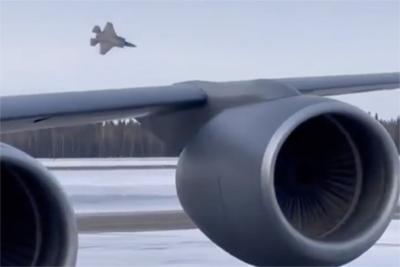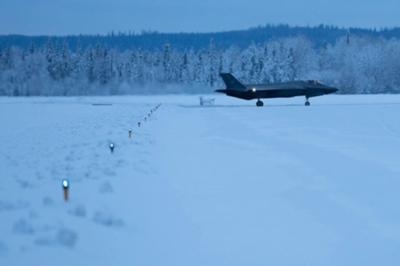Landing Gear Froze While Waiting On Ground After Engine Start
Freezing temperatures and water-contaminated hydraulic fluid combined to bring down an F-35A Lightning II on January 28 at Eielson Air Force Base near Fairbanks, Alaska. After the pilot attempted to troubleshoot the issue for nearly an hour, the aircraft stopped responding to control inputs so he ejected safely and walked under his own power to an ambulance as the aircraft crashed in a fireball on the base.

The aircraft had sat on the ground for 40 minutes after engine start while five other aircraft in the sortie were dealing with minor issues, and then the nose gear failed to retract properly on takeoff.
The pilot was very experienced, with nearly 1,700 flight hours in the A-10 Thunderbolt II attack jet and 555 hours in the F-35.
After noting that the nose gear did not retract properly the pilot tried to extend it, but it would not fully extend or lock into place because it was also canted to the left. Unable to determine why the gear was not functioning properly, the pilot and his wingman circled the field at 9,500 feet while the pilot called in to the base tower, who set up a call with Lockheed Martin engineers to devise a course of action.
Two unsuccessful touch and go maneuvers only caused more ice buildup in the nose and main gear, and apparently the sensors thought the aircraft was on the ground. Due to all the gear sensors agreeing, the F-35’s main computer switched to on-ground control laws rather than in-flight control laws.
As the pilot continued maneuvering, the aircraft entered “significant oscillations” and then would not respond to the pilot’s control inputs so he ejected at just 372 feet above the runway. The jet climbed and then stalled at 3,205 feet, and passed by the pilot under parachute as it crashed on the field.
The rest of the story is that enough of the landing gear survived and investigators found that the hydraulic fluid was in fact 30% water, enabling it to freeze at a higher temperature.

Both the barrel and servicing cart containing the hydraulic fluid tested at more than double the limit for particulates in the fluid. Investigators also found the 355th Fighter Generation Squadron was short-staffed and without a dedicated hazardous materials program manager. The barrels weren’t locked, the servicing of the cart was unsupervised, and the pump on top of the barrels had no thread sealer, which could allow water to penetrate. Records for tracking equipment usage were spotty.
Investigators noted, “These are significant lapses in following procedures that indicate an overall lack of discipline.”
Interestingly, investigators found that Lockheed Martin issued a notice in April 2024 that landing gear weight sensors could lead to control issues, particularly in extreme cold weather. Knowing that could have led to advising a full-stop landing instead of touch-and-go maneuvers.
 ANN's Daily Aero-Linx (08.27.25)
ANN's Daily Aero-Linx (08.27.25) ANN's Daily Aero-Term (08.27.25): Class C Service
ANN's Daily Aero-Term (08.27.25): Class C Service ANN FAQ: Submit a News Story!
ANN FAQ: Submit a News Story! Airborne-NextGen 08.26.25: Iran UAV Knockoffs, X-37B Spaceplane, Army Training
Airborne-NextGen 08.26.25: Iran UAV Knockoffs, X-37B Spaceplane, Army Training Classic Klyde Morris (08.25.25)
Classic Klyde Morris (08.25.25)




